ASRock FM2A85X Extreme6 Review
by Ian Cutress on December 3, 2012 12:00 PM EST- Posted in
- Motherboards
- AMD
- ASRock
- Trinity
- FM2
USB Speed
For this benchmark, we run CrystalDiskMark to determine the ideal sequential read and write speeds for the USB port using our 240 GB OCZ Vertex3 SSD with a SATA 6 Gbps to USB 3.0 converter. Then we transfer a set size of files from the SSD to the USB drive using DiskBench, which monitors the time taken to transfer. The files transferred are a 1.52 GB set of 2867 files across 320 folders – 95% of these files are small typical website files, and the rest (90% of the size) are the videos used in the Sorenson Squeeze test.
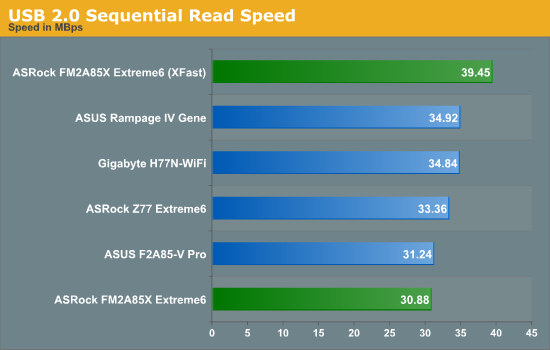
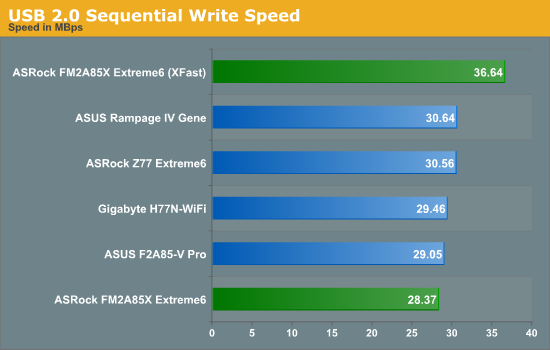
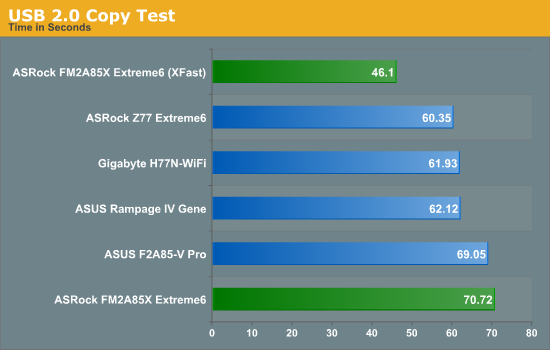
For USB 2.0, it alarmingly comes down to an Intel advantage over AMD. Compared to the ASUS FM2 board we have tested, the ASRock also lags behind slightly. With use of XFast USB however, the ASRock does claw back some time compared to all the other systems.
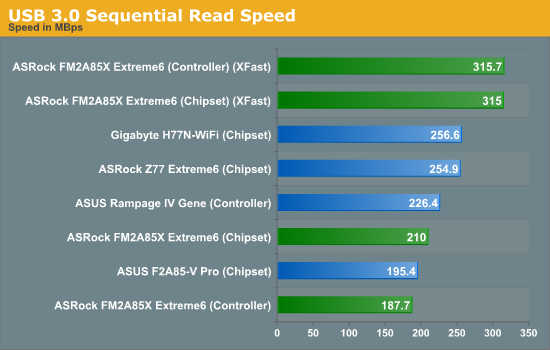
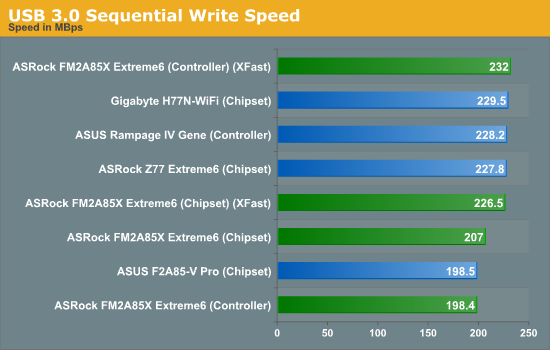
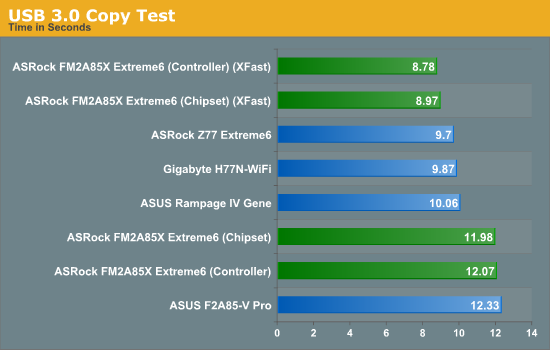
Similarly with USB 3.0, under Windows 7 and despite the AMD systems having native USB 3.0, there is a distinct dichotomy between Intel and AMD, even with controllers on Intel products (like the RIVG). The ASRock still remains competitive with XFast USB however.
DPC Latency
Deferred Procedure Call latency is a way in which Windows handles interrupt servicing. In order to wait for a processor to acknowledge the request, the system will queue all interrupt requests by priority. Critical interrupts will be handled as soon as possible, whereas lesser priority requests, such as audio, will be further down the line. So if the audio device requires data, it will have to wait until the request is processed before the buffer is filled. If the device drivers of higher priority components in a system are poorly implemented, this can cause delays in request scheduling and process time, resulting in an empty audio buffer – this leads to characteristic audible pauses, pops and clicks. Having a bigger buffer and correctly implemented system drivers obviously helps in this regard. The DPC latency checker measures how much time is processing DPCs from driver invocation – the lower the value will result in better audio transfer at smaller buffer sizes. Results are measured in microseconds and taken as the peak latency while cycling through a series of short HD videos - less than 500 microseconds usually gets the green light, but the lower the better.
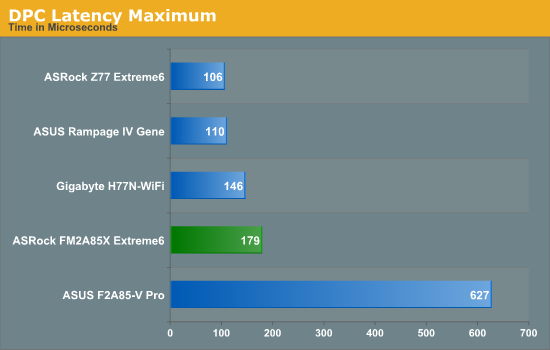
All ASRock products in the past 12 months have given a score below 200 microseconds, which is a great sight to see. Here is no different, and the FM2A85X Extreme6 gives a score of 179 microseconds.
Rightmark Audio Analyser
Rightmark Audio Analyser is a commonly used tool to confirm quality within an audio setup. It tests features such as noise levels, dynamic range, harmonic distortion, stereo crosstalk, and general performance. The nature of the software makes it hard to compare two different setups, unless they are equal (including volume control and effects). Rightmark:AA outputs the scores and gives them a rating from Very Poor to Excellent. We use the Dynamic Range and THD+N results for publication under 16-bit resolution for 48 kHz, 96 kHz and 192 kHz.

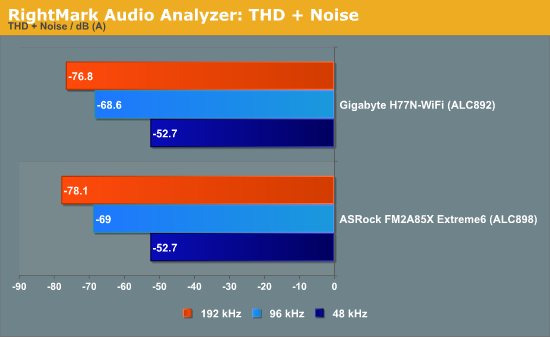










19 Comments
View All Comments
Garestle - Thursday, March 26, 2020 - link
Click on https://www.google.com/">google and get more infoslacr - Tuesday, December 4, 2012 - link
I wish there were high end FM1-2 motherboards that include more than the standard 6-7 SATA ports. For a HTPC/storage solution with lower power consumption than my current P45/Q6600 setup, having to go really high end Z77 or similar in order to get to the 9-10 SATA port cards, or buying separate (expensive) sata controllers is not great.ForeverAlone - Tuesday, December 4, 2012 - link
Why the dual PCI-E slots? None of the APU processors are powerful enough to properly support crossfireX or SLI anyway. Pointless.Even the A10-5800K isn't going to have enough power to support a proper Crossfire setup. Crossfiring anything below a 6850 is a stupid idea. An A10 won't support crossfired 6850s.
CeriseCogburn - Sunday, December 9, 2012 - link
Don't worry g, you are not alone - you are correct.It's called AMD fanboyism - and the marketing PR team decided so long as they hack out the insane non workable boards, the amd fanboys will buy them, telling themselves all is well in fanboyville.
Nil Einne - Monday, March 25, 2013 - link
Whoever told you two PCI express is only used for graphics cards appears to be the real fanboy here ....jobby99 - Friday, January 18, 2019 - link
Some people need low cpu and graphics memory only. Thus, they have some insane multi-monitor setups with two independent video cards. Coders for one use at least two monitors. Financial analysts use 3 or 4 for day trading. I just wouldn't assume crossfire is the only use for two or more video cards.batguiide - Sunday, December 9, 2012 - link
Thanks for these tips! I love the tip about checking where the model is in the store. I just finished reading another article that has some more research based tips about making sure you get the best big ticket items for you, which I also found useful. website:[socanpower,ca]Thanks again and happy shopping! Power supply Australia!
xerces8 - Thursday, December 20, 2012 - link
How is 12 sec a fast boot time?I have a cheap Medion PC which also has 12 seconds from power switch to boot menu (the one loaded from the boot sector).
2 seconds is fast. (my previous Asus netbook had such boot/POST times)
But kudos for actually measuring this usually neglected property.
PS: For more accurate measuring configure the boot loader to present a menu. Or even beep (should be trivial with GRUB). Also recording the measurement on video should make it easier to read the timings)
Nil Einne - Monday, March 25, 2013 - link
Combining DVI-D with D-sub isn't going to work since the D-sub is supposed to be usable with the HDMI and DVI-D for triple monitor/Eyefinity support. (While some dislike D-sub for these purposes because of the quality loss due to the D-A-D conversion steps it's still fairly popular because many monitors still have D-sub ports but lack Displayport and they can't be bothered spending for an active converter to get HDMI/DVI from the Displayport.)